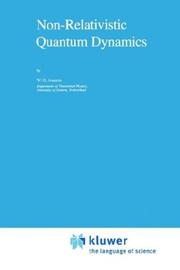| Listing 1 - 3 of 3 |
Sort by
|

ISBN: 9027713243 9401003165 9789027713247 Year: 1981 Volume: v. 2 Publisher: Dordrecht ; Boston, MA : D. Reidel,
Abstract | Keywords | Export | Availability | Bookmark
 Loading...
Loading...Choose an application
- Reference Manager
- EndNote
- RefWorks (Direct export to RefWorks)
Quantum theory --- Operator theory --- Théorie quantique --- Théorie des opérateurs --- Nonrelativistic quantum mechanics --- 530.1 --- Basic principles of physics --- Nonrelativistic quantum mechanics. --- Operator theory. --- 530.1 Basic principles of physics --- Théorie quantique --- Théorie des opérateurs --- Functional analysis --- Non-relativistic quantum mechanics --- Nonrelativistic quantum dynamics --- Nonrelativistic quantum theory --- Relativity (Physics)
Book
ISBN: 366265590X 3662655918 Year: 2022 Publisher: Berlin, Germany : Springer,
Abstract | Keywords | Export | Availability | Bookmark
 Loading...
Loading...Choose an application
- Reference Manager
- EndNote
- RefWorks (Direct export to RefWorks)
Collisions (Nuclear physics) --- Nonrelativistic quantum mechanics. --- Non-relativistic quantum mechanics --- Nonrelativistic quantum dynamics --- Nonrelativistic quantum theory --- Quantum theory --- Relativity (Physics) --- Bombardment with particles --- Electron collisions --- Impact phenomena (Nuclear physics) --- Nuclear collisions --- Particle collisions (Nuclear physics) --- Particles (Nuclear physics) --- Collisions (Physics) --- Collisions
Book
ISBN: 3031370732 3031370724 Year: 2023 Publisher: Cham : Springer Nature Switzerland : Imprint: Springer,
Abstract | Keywords | Export | Availability | Bookmark
 Loading...
Loading...Choose an application
- Reference Manager
- EndNote
- RefWorks (Direct export to RefWorks)
Currently, relativistic quantum mechanics is considered an advanced topic only accessible to students who have already received considerable training in non-relativistic quantum mechanics. However, the authors believe that they have found an excellent pedagogic approach for simultaneously introducing both topics. This book is considered an Introductory Quantum Mechanics textbook that presents relativistic quantum mechanics to interested learners with no previous knowledge of it. The authors avoid utilization of the well-known Lorentz invariant equations. Additionally, they only refer to the Klein-Gordon and Dirac equations to justify the use of the Poveda-Poirier-Grave de Peralta (PPGP) equations, upon which this book is solely based (while sporadically referring to well-known results obtained using the Klein-Gordon and Dirac equations to avoid unnecessary complications in an introductory book). There also exist two complementary Schrödinger-like and Pauli-like PPGP equations, the solutions of which are identical to the respective solutions of the Klein-Gordon and Dirac equations associated with negative kinetic energies. These equations’ relation to the existence of antiparticles is discussed. The intended readership is undergraduate physics, chemistry, and engineering students with no previous knowledge of quantum mechanics, as well as graduate students and professionals interested in the subject.
Nonrelativistic quantum mechanics. --- Quantum theory. --- Quantum dynamics --- Quantum mechanics --- Quantum physics --- Physics --- Mechanics --- Thermodynamics --- Non-relativistic quantum mechanics --- Nonrelativistic quantum dynamics --- Nonrelativistic quantum theory --- Quantum theory --- Relativity (Physics) --- Gravitation. --- Particles (Nuclear physics). --- Mechanics. --- Classical and Quantum Gravity. --- Particle Physics. --- Classical Mechanics. --- Classical mechanics --- Newtonian mechanics --- Dynamics --- Elementary particles (Physics) --- High energy physics --- Nuclear particles --- Nucleons --- Nuclear physics --- Field theory (Physics) --- Matter --- Antigravity --- Centrifugal force --- Properties
| Listing 1 - 3 of 3 |
Sort by
|

 Search
Search Feedback
Feedback About UniCat
About UniCat  Help
Help News
News